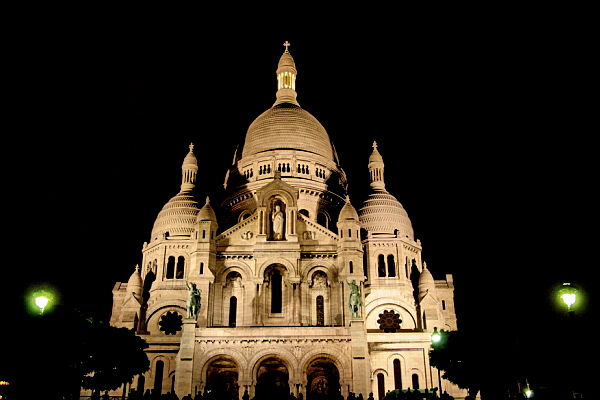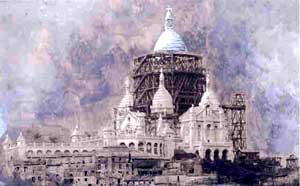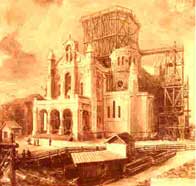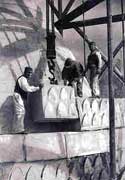Montmartre - Sacre Coeur

The hill of Montmartre in the North of Paris rises 129 meters above sea-level.

The name signifies " mount of martyrs " because by tradition it is the place of the martydom of Saint Denis, the first bishop of Paris (late 3rd century) and his companions.
Many saints have come to this hill (Saint Germain - Saint Clotilde - Saint Bernard - Saint Joan of Arc - Saint Vincent de Paul, …) and, of course, Saint Ignatius of Loyola and Saint Francois-Xavier who, with their companions, founded the Society of Jesus (Jesuits) here in 1534.
A big benedictine Abbey occupied the whole hill until the French Revolution at which date the nuns were guillotined and the Abbey destroyed. A village called Saint Peter's survived in this former lime quarry in the late XIXth century ; the working people were short of employment.

In 1870, war broke out between France and Germany. The Council taking place at the Vatican broke up and the Pope, no longer protected by French troops, felt himself to be a prisoner in the Vatican City. France faced military defeat and occupation of part of the country by German troops. The response of MM. Alexandre Legentil and Hubert Rohault de Fleury was spiritual. They vowed to build a church consecrated to the Heart of Christ in reparation (iin penitence for sins commited) since for them, the misery of France stemmed more from spiritual than from political causes
Late 1872 : Cardinal Guibert, archbishop of Paris, approves this vow and chooses Montmartre.
Late 1873 : he obtains a parliamentary declaration of the public utility of the Basilica, thus enabling the land to be used to built the church
At the time, the building of a Basilica dedicated to the Heart of Christ is unusual compared with the series of Basilicas dedicated to Mary built during the same period : Lourdes, Notre-Dame of Fourviere at Lyon, Notre-Dame of la Garde at Marseille.
The work was financed by gifts, often modest, from all over France.The names of the donors are carved in the stone.
The architecture / The construction

The architect is Paul ABADIE, but six architects succeeded him before the building was completed.
The style is Romano-byzantine, that is to say in contrast with the gothic style of medieval churches such as Notre Dame of Paris (1163-1240)
The style was inspired by models such as Saint Sophia at Constantinople, Saint Mark's at Venice or Ravenna.
-
Key dates:
1875: Laying of the foundation stone, and then several months work on the foundations : underpinning pits 33 meters deep are needed. Filled up, they become the pillars on which the edifice rests. Without these pillars, the Basilica would sink into the clay.
1878: Work begins on the crypt
1881: Work begins on the Basilica itself
1914: All is ready for the consecration including the tower containing the "Savoyarde" a 19 tons bell. But the First World War breaks out (1914-1918)
1919: Consecration on the 16th of October 1919
-
Interior
Also in romano-byzantine style
The great mosaic was created between 1900 and 1922.
The stained-glass windows were installed between 1903 and 1920.
They were destroyed by bombing in 1944 and restaured in 1946.
The great organ is by Cavaille- Coll.
Dimensions :85 meters wide, 35 meters long.
The Dome is 83 meters high.
The Cupola is 55 meters high and 16 meters wide.
From in front of the Basilica, you can see the whole city of Paris. A visit to the dome at a height of 200 meters above sea-level provides a panorama of 50 kms all around. It is thus the highest point in Paris after the Eiffel Tower (built in 1889!)
At its consecration, the church was titled a basilica, that is to say a place of pilgrimage.
The Sacred Heart of Christ is worshipped there in the mystery of the Eucharist (the mass).